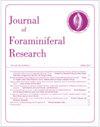Living foraminifera in the shallow waters of Admiralty Bay: distributions and environmental factors
IF 0.9
4区 地球科学
Q4 PALEONTOLOGY
引用次数: 5
Abstract
The living foraminiferal fauna and associated environmental factors were examined using shallow-water sediment and bottom-water samples collected in the Admiralty Bay (King George Island, Antarctica) during the austral summer of 2004–05. Admiralty Bay has similar environmental characteristics to other Antarctic coastal areas, with bottom water rich in inorganic nutrients and heterogeneous bottom sediments with high concentrations of mud and sand. We found 45 foraminiferal species, including 28 agglutinated and 17 calcareous species. The dominant species were the calcareous Bolivina pseudopunctata and the agglutinated Pseudobolivina antarctica and Portatrochammina antarctica . Only the agglutinated Spiroplectammina biformis was found in all samples. Admiralty Bay contained a typical Antarctic foraminiferal fauna, mainly distinguishable by the type of bottom sediment. We detected two distinct assemblages: (a) from the entrance of the bay area with a main channel, we found an assemblage with relatively high species richness, abundance and diversity, and with abundant Bolivina pseudopunctata and Fursenkoina fusiformis ; and (b) in the inner parts of the three inlets of the bay (Ezcurra, MacKellar, and Martel inlets), mud- and sulfur-rich sediments contained relatively few foraminifers dominated by a few species, mainly of Globocassidulina and Cassidulinoides .金钟湾浅水区的活有孔虫:分布及环境因素
利用2004 - 2005年南极乔治王岛金钟湾浅水沉积物和底水样品,对有孔虫区系及其相关环境因子进行了研究。金钟湾的环境特征与南极其他沿海地区相似,底部水富含无机营养物质,底部沉积物呈非均质,泥沙浓度高。共发现有孔虫45种,其中凝集类28种,钙质类17种。优势种为钙质伪球藻、凝集南极伪球藻和南极伪球藻。在所有样品中只发现了凝集的双形螺旋体。金钟湾有典型的南极有孔虫动物群,主要以底部沉积物的类型来区分。我们发现了两个不同的组合:(a)在有主通道的湾区入口处,我们发现了一个物种丰富度、丰度和多样性相对较高的组合,其中有丰富的伪孔虫(Bolivina pseudoopunctata)和fususiformis;(b)富泥和富硫沉积物中有孔虫相对较少,以Globocassidulina和Cassidulinoides类为主。
本文章由计算机程序翻译,如有差异,请以英文原文为准。
求助全文
约1分钟内获得全文
求助全文
来源期刊
CiteScore
2.10
自引率
9.10%
发文量
32
审稿时长
>12 weeks
期刊介绍:
JFR publishes original papers of international interest dealing with the Foraminifera and allied groups of organisms. Review articles are encouraged.

 求助内容:
求助内容: 应助结果提醒方式:
应助结果提醒方式:


